- Announcements
- BBQ and Food
- Cars
- Computing
- Cool Stuff
- Current Events
- Electric Vehicles
- Electronics
- Energy
- Flashahaulism
- Funny
- Government
- Hints and Tips
- History
- HVAC
- Induction heating
- Internet
- Lighting
- Misc
- Neon and other lighting
- Nuclear
- Personal
- Pets
- Philosophy
- Photography
- Power Generation
- Product Reviews
- Projects
- Q and A
- RV/Camping
- Science
- Tellico
Categories
Blogroll
 Print This Post
Print This Post
The Little Generator that could – Part Deux
PermaLink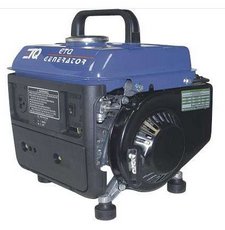 In response to my first article about little generators, specifically the little $100 ChiCom Special, Mike Hendrix asked the following
In response to my first article about little generators, specifically the little $100 ChiCom Special, Mike Hendrix asked the following
When I plugged my motorhome in to it I notice that my circuit tester says the Neutral & hot wires are crossed.
Do you think I should disassemble and switch the connections on the output plug?
The outlet tester being a little gadget that you plug into an outlet and that indicates correct wiring on a series of 3 or more neon lights or LEDs. Normally Mike’s concern is serious, as it could lead to shocks and will often make GFIs trip on apparent neutral faults.
With a generator, things are a little different. There are two leads coming out of a generator. Either one can be designated as hot and the other neutral, the neutral being connected to earth ground, or they can be allowed to float. In the case of floating leads, neither lead is hot nor neutral because those terms are ground-referenced.
Between the time I posted the last article and this one, I had a friend pick up the last two $99 specials that the Chattanooga Northern Tool store had in stock. I figured that I could sell my old ones for more than I paid for the new ones when the power goes out up here. Turns out that I was a visionary :-) I sold my red one to some camper/rafters who had not come prepared for dry or primitive camping. They had a heater (yep, more than 1000 watts) but no generator, thinking they could pitch a tent in the RV park and plug in. The park is closed this time of year and besides, they don’t rent short term like that. I fixed them right up for a mere $120.
So I have a couple of brandy new generators on my hands, though probably not for long. I decided to open one up and see what was under the hood and answer Mike’s question at the same time. I was very pleased to discover that they’ve made several improvements in the unit over the ones that I bought a couple of years ago. Most significantly, they’ve fixed the choke problem.
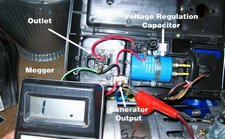 First to Mike’s question. This is the back side of the front panel of the generator. Several items are identified including the voltage regulator capacitor, the outlet and the two leads coming from the generator. If you look closely at the outlet, you’ll see that neither of the other wires are connected to the green ground wire. The output is floating. This is further confirmed by the megger, the display of which is visible in the lower left. It is saying that the resistance between the output (red clip) and ground is >1.999 Gigaohm at 500 volts. Damn fine insulation, rarely seen in rotating machinery.
First to Mike’s question. This is the back side of the front panel of the generator. Several items are identified including the voltage regulator capacitor, the outlet and the two leads coming from the generator. If you look closely at the outlet, you’ll see that neither of the other wires are connected to the green ground wire. The output is floating. This is further confirmed by the megger, the display of which is visible in the lower left. It is saying that the resistance between the output (red clip) and ground is >1.999 Gigaohm at 500 volts. Damn fine insulation, rarely seen in rotating machinery.
So Mike, the answer is NO, you don’t need to rewire anything. If you don’t like a floating system, you could select one wire, say, the one that connects to the wide slot on the outlet (red wire in this photo) and tie it to the green wire to make a neutral. I personally would not. This increases the shock potential over a purely floating system. See my comments on the first article for more details.
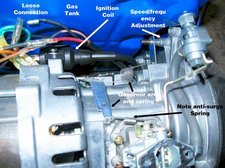 While I had the unit open, I decided to photograph and describe some other features. Several things stand out. One, the simplicity of the governor and the attention to its details. Note the small spring labeled “anti-surge spring”. This spring takes up the slop in the linkage. While not an issue initially, as the linkage wears, the increased slop can cause surging. That little spring handles the situation nicely.
While I had the unit open, I decided to photograph and describe some other features. Several things stand out. One, the simplicity of the governor and the attention to its details. Note the small spring labeled “anti-surge spring”. This spring takes up the slop in the linkage. While not an issue initially, as the linkage wears, the increased slop can cause surging. That little spring handles the situation nicely.
On a negative note, notice the loose connection on the black wire at the upper left. I sure am glad that I took this unit apart, for that is part of the ignition circuit and would have driven me crazy trying to start a generator with no spark!
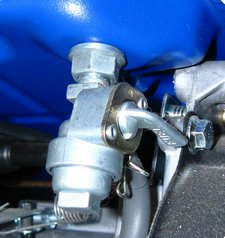 This photograph shows a small but nice detail. A genuine metal Japanese-style fuel cock with a reserve position and sediment bowl. Beats the heck out of the plastic valve that “brand names” like Generac use.
This photograph shows a small but nice detail. A genuine metal Japanese-style fuel cock with a reserve position and sediment bowl. Beats the heck out of the plastic valve that “brand names” like Generac use.
Also note the drain screw, something missing on generators costing vastly more. This screw lets you drain the last remnants of gasoline from the bowl before you store the generator.
And if you forget? That single nut makes removing the bowl for cleaning a snap. The bowl can be removed without removing the carb or the front panel. Nice.
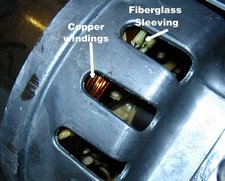 This shot is looking in through the generator vent holes. Notable here is that the windings are copper. Many cheap (but much more expensive) generators have aluminum windings to save money since copper costs so much more than aluminum. This little $100 jewel has genuine copper in its windings. Also note the quality of the aluminum injection casting. That’s Japanese-quality work.
This shot is looking in through the generator vent holes. Notable here is that the windings are copper. Many cheap (but much more expensive) generators have aluminum windings to save money since copper costs so much more than aluminum. This little $100 jewel has genuine copper in its windings. Also note the quality of the aluminum injection casting. That’s Japanese-quality work.
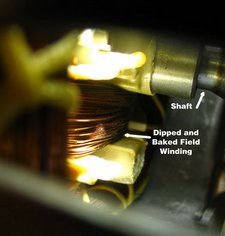 In this shot, the camera lens is positioned up against one of those slots and is looking at the rotor. Several things are apparent. First, copper windings again. Second, the whole affair has been dipped in varnish and baked, a standard treatment for industrial motors and generators but extremely rare on portable generators.
In this shot, the camera lens is positioned up against one of those slots and is looking at the rotor. Several things are apparent. First, copper windings again. Second, the whole affair has been dipped in varnish and baked, a standard treatment for industrial motors and generators but extremely rare on portable generators.
The varnish hardens during the bake to form a solid mass that is practically impervious to water, oil, dirt and other gunk. Even I was surprised to see that level of quality on this unit.
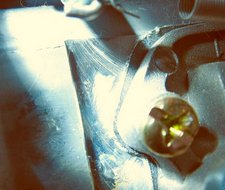 This not-very-good photo is a close-up of the carburetor mounting surface. I took this photograph to demonstrate the quality of machining. The lighting and smear of gasket sealer doesn’t do it justice. The finish is almost mirror-like, with only the slightest feel of grooves apparent to the fingernail. In my experience with CNC machining, this level of finish is usually only seen when either diamond or ceramic bits are used and the machine is tighter than Dick’s hatband. Remarkable for a unit this inexpensive.
This not-very-good photo is a close-up of the carburetor mounting surface. I took this photograph to demonstrate the quality of machining. The lighting and smear of gasket sealer doesn’t do it justice. The finish is almost mirror-like, with only the slightest feel of grooves apparent to the fingernail. In my experience with CNC machining, this level of finish is usually only seen when either diamond or ceramic bits are used and the machine is tighter than Dick’s hatband. Remarkable for a unit this inexpensive.
 Here is another photo showing quality details. What you see is the stator “iron”, actually a sophisticated silicone steel. It is made up of stacks of thin stampings called laminations. The laminations are insulated from each other and prevent eddy currents from flowing in the iron, creating heat and inefficiency.
Here is another photo showing quality details. What you see is the stator “iron”, actually a sophisticated silicone steel. It is made up of stacks of thin stampings called laminations. The laminations are insulated from each other and prevent eddy currents from flowing in the iron, creating heat and inefficiency.
All else being equal, the thinner the laminations, the better. These are extremely thin. The laminations in my high dollar Generac generator are twice as thick. It costs more to stamp that many thin laminations but it contributes to a more efficient generator. Again, I’m shocked and amazed to see this in a $100 generator.
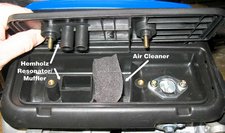 This last photo addresses something that started a tempest in a teapot in the Usenet RV group. Noise. Most of the noise from a 2-stroke comes from the intake. This is a reed-valve-type engine. The reed valve allows air to flow into the engine from the carburetor but prevents its reverse flow. When the thin reeds slam shut, they make a loud pop. 3600 times a minute on this machine.
This last photo addresses something that started a tempest in a teapot in the Usenet RV group. Noise. Most of the noise from a 2-stroke comes from the intake. This is a reed-valve-type engine. The reed valve allows air to flow into the engine from the carburetor but prevents its reverse flow. When the thin reeds slam shut, they make a loud pop. 3600 times a minute on this machine.
The only complaint that I had with the old unit was that at full load, the intake roar was about the only sound heard. While not loud like a construction generator, it was louder than I’d have liked.
I guess those crafty little ChiComs thought so too, because they’ve put physics to work neutralizing the roar. Specifically, the’ve redesigned the air intake to form a Helmholtz resonator (yeah, I know I mis-spelled it in the photo. The software I was using would not “undo” and I didn’t feel like starting over again.) This resonator is tuned to the frequency of the intake roar and creates a sound wave of the same amplitude but of opposite polarity from the one coming from the engine. The result is that they cancel each other.
This unit is significantly quieter than my previous one. I can’t find my decibel meter so I can’t quantify the difference but it is significant. Further contributing to the reduction in noise is the use of a sound-deadening plastic compound and the heavy reinforcing of the cover which dampens resonances before they can happen.
To summarize, I’m even more impressed with this generator than I was before. The incremental improvements just add to the inherent quality. Oh, and for the certain individual who claimed that he would not buy one because he “probably” could not get spare parts for it, the manual is 25 pages long, 10 of which are exploded diagrams and part number call-outs. The company that imports these things had a website and can be contacted toll-free at 888-908-6200. Personally, I can’t imagine spending any time repairing a $100 generator but hey, others are different.
So, while you can’t buy a set of piston rings for a $600 Honda EU1000i, you CAN buy a set (or any other part) for this $100 ChiCom special. Hmmmm.
Speaking of inverter generators, if you simply MUST have an inverter generator, the same company has one for you. Here. Amazon has it for $300 and free shipping.
Wait, oh heck, what is that? I think my debit card may be chewing its way out of my wallet. Oh noooooooooo……..
Posted by neonjohn on December 31st, 2008 under Cool Stuff, Power Generation, RV/Camping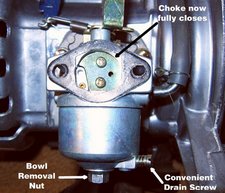
December 31st, 2008 at 8:59 am
Both interesting and well written, NJ! Thanks for posting it.
December 31st, 2008 at 11:09 am
I too.. buy and sell.. [not on purpose] these things.. it just when your using it someone just ‘happens’ to need one.. Keeps me up to date on the newest models and makes a friend… and a sawbuck or so for myself.. :)
Good info.. thanks.. -gar
December 31st, 2008 at 3:08 pm
John…. great review!!
What abt two cycle generators though? Are they a pain in the you know what to operate?
December 31st, 2008 at 6:22 pm
John:
Two strokes are no longer the problem they used to be. Two reasons. One, the much improved oils, especially the synthetics, allow a very lean mixture to be used. I use 80:1 in my stuff. That means much less oil to foul plugs. Generally the synthetics don’t (partially) burn. They simply vaporize and exit the exhaust more or less intact. That is another factor limiting fouling.
The second major improvement is the ignition. The old point contact energy transfer type ignitions were weak to begin with and the high voltage had a slow rise time which gave it time to leak off over plug deposits instead of sparking.
The ignition on this unit, like on most 2-strokes made in the last 10-15 years, is a high energy capacitor discharge system. The “black box” that makes this happen is barely visible in photo #2 over at the extreme right.
This system is fully electronic with no points (pointless? :-) The high voltage rise time is extremely rapid. The spark will generally jump over the gap of all but the most fouled of plugs.
Before they were available from the factory, I used to design and build capacitor discharge ignition systems for my racing bikes. One demo was to dip a plug in oil, connect it to the system and crank over the engine. It would spark right through the oil!
Another minor contribution is the improved carburetor designs, mostly caused by EPA regs. That’s a double-edged sword, though, because the same regs force the engines to run far lean of optimum.
The only thing keeping modern 2-strokes from being one-pull starters is the need to wet the crankcase parts with gas before the vapor can get to the combustion chamber. Until the crankcase is wet, the gas simply condenses as a liquid on the cold parts.
This new generator is giving all indications of being a consistent 3 pull starter when cold. Two pulls to wet things and one pull to actually start it.
John
January 11th, 2009 at 6:01 pm
I just bought one of these, mainly because of reading about it here and in your usenet postings. What a great little unit! I got it for backup power for the furnace, in case we get an ice storm or another August 2003 knocking out the power for a few days. Took me about 4 hours all together to get set up to try it, and that includes going out to Wallyworld to buy one of these, plus a bunch of parts at Home Despot to, er, facilitate powering the furnace from an extension cord. Just gave it a try and it worked great. The one part of my plan that didn’t work was the idea to siphon gas from the car to fuel the thing. Either I’m doing it wrong or there’s something about the tank design that deliberately makes it hard to do that (maybe to discourage theft?) I’m probably going to have to arrange a method of getting fuel from the fuel line instead, as you’ve mentioned somewhere I think. I’ve got some “emergency fuel” in portable containers right now, just hate the thought that there could be all this gas sitting in the car with no way to get to it in an emergency. It’s going to be about -8 F here later this week… might just try to fire up this little generator again and see how it does in that kind of temperature.
March 16th, 2009 at 8:35 pm
John, my little unit malfunctioned while really exercising it when we were recently boondocking in Key West for almost a month. Anyway, I like the unit but it developed a problem that was going to require taking the generator apart. They were willing to send me the parts “free” (it was under warranty). Or I could just send them the generator and they would either fix or replace the unit. I decided to return the generator to them. It was an easy process. I received what looks like a brand new generator this afternoon. I am telling you this so you will have info concerning how well their warranty works and availability of parts. They obviously have a stock pile of parts and will send them out immediately. I do not think parts will be a problem for this unit. I am still happy. My unit would put out 8-amps although it seldom had to. Most of the time it was just putting out 2 to 5 amps while charging the batteries and running a few small appliances in the motorhome. What I liked most is running around 9-hours on a gallon of gas. It is also surprising quiet even compared to a Honda or Yahama. The Yamaha’s and Honda’s on either side of us were about the same when generating 2 to 5 amps and louder (much louder) when producing greater amps.
mike
—
March 19th, 2009 at 9:37 am
John, I just looked at the Northern Tool web site this morning (March 19, 09) and that little genny is $169. I really love my $99 model. When mine had a problem and I sent it back they shipped me a brand new unit. That got me to thinking—-what are they doing with the units that people return? I called them this morning (they are a small company and the same girl, Amy, answers every time, to ask what they did with the repaired units. She told me that they were getting a stock pile of them then they would offer them at a discount price. She told me to call back in June or July to see if they had started that program.
All I can say is they better be selling them cheaper than $99. VBG
mike
—
May 22nd, 2009 at 12:02 pm
A wire undone ? It most likely was not run and tested an the build site.
How do you know the “varnish” is “baked ?”
It looks like copper wire, are you sure? It’s not plated ?
What the Hell is “sophisticated Silicone Steel?” How did you determine that? I have never heard of “silicone” steel !
“remarkable for a unit this inexpensive”
Boy you sure are talking these things up good!
The proof will be in long time durability,not just observations.
It’s a product from a communist country,and that is not good.
July 17th, 2009 at 6:59 pm
I’m thinking a building a little doohickey platform for one of these that plugs into my 2″ trailer hitch receiver, and solidly holds the generator. In addition to being a convenient place to put your generator, you can even then plug the battery charger output into the 7 pin trailer connector and recharge the vehicle battery if necessary.
-Bruce
October 21st, 2009 at 10:14 pm
Most refridgerators (mine at least) run 115V and 6.5 amps… That is like 750watts… What is the starting watts? Could this generator run it and by this generator I mean the 1000Watt Chi com jobs…
February 22nd, 2010 at 10:30 am
Hi John,
Your site is quite informative. Could you furnish us with information on where and how this inverter generator can be purchased. Either used or new ones Honda GX-31 Mini 4 stroke engine or the type you bought from Harbour freight in 2007.
Hope to hook up to your blog often. Thanks